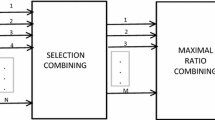Abstract
In this paper, a closed-form expression for the probability of error in a coherent BPSK system over Generalized Rayleigh fading channels is derived. An L-branch equal gain combining diversity scheme is used. Theoretical results for the probability of error are plotted for various values of the number of degrees of freedom (n) and diversity order (L). A simulation is performed and the simulated results are found to match very well with the theoretical results.

Similar content being viewed by others
References
J. G. Proakis, Digital Communications, 4th ed. McGraw Hill, NY, 2001.
W. Jakes, Microwave Mobile Communications, 2nd ed. IEEE Press, Piscataway, NJ, 1994.
R. Steele and L. Hanzo, Microwave Radio Communications, Wiley Publications, 1999.
Q. Zhang, Probability of error for equal-gain combiners over Rayleigh channels: some closed-form solutions. IEEE Transactions on Communications, Vol. 45, No. 3, pp. 270–273, 1997.
Y. Chen and C. Tellambura, Performance analysis of L-branch equal gain combiners in equally correlated Rayleigh fading channels. IEEE Communications Letters, Vol. 8, No. 3, pp. 150–152, 2004.
F. Digham and M. Alouini, Average probability of packet error with diversity reception over arbitrarily correlated fading channels. Journal of Wireless Communications and Mobile Computing, Vol. 4, No. 2, pp. 155–173, 2004.
R. Annavajjala and L. Milstein, On the performance of diversity combining schemes on Rayleigh fading channels with noisy channel estimates. IEEE Military Communications Conference, Vol. 1, pp. 320–325, 2003.
B. Bjerke, Z. Zvenar, and J. Proakis, Antenna diversity combining schemes for WCDMA systems in fading multipath channels. IEEE Transactions on Wireless Communications, Vol. 3, No. 1, pp. 97–106, 2004.
A. Sulyman and M. Kousa, Bit error rate performance analysis of a threshold based generalized selection combining scheme in Nakagami fading channels. Eurasip Journal on Wireless Communications and Networking, Vol. 2005, No. 2, pp. 242–248, 2005.
M. Do and S. Wu, Hybrid diversity combining techniques for DS-CDMA over a multipath fading channel. International Journal of Wireless Networks, Vol. 3, No. 2, pp. 155–158, 1997.
R. Annavajjala and L. Milstein, Performance analysis of linear diversity-combining schemes on Rayleigh fading channels with binary signaling and gaussian weighting errors. IEEE Transactions on Wireless Communications, Vol. 4, No. 5, pp. 2267–2278, 2005.
P. Shankar, Performance analysis of diversity combining algorithms in shadowed fading channels. International Journal of Wireless Personal Communications, Vol. 37, No. 1-2, pp. 61–72, 2006.
L. Goldfeld and D. Wulich, Adaptive diversity reception for Rayleigh fading channel. European Transactions on Telecommunications, Vol. 14, No. 4, pp. 367–372, 2003.
J. Cheng and N. Beaulieu, Accurate DS-CDMA bit-error probability calculation in Rayleigh fading. IEEE Transactions on Wireless Communications, Vol. 1, No. 1, 2002.
Y. Ma and T. Lim, Bit error probability for MDPSK and NCFSK over arbitrary Rician fading channels. IEEE Journal on Selected areas in Communications, Vol. 18, No. 11, pp. 2179–2189, 2000.
N. Kong and L. Milstein, Average SNR of a generalized diversity selection combining scheme. IEEE Communications Letters, Vol. 3, No. 3, pp. 57–59, 1999.
S. Kotsopoulos and G. Karagiannidis, Error performance for equal-gain combiners over Rayleigh channels. Electronic Letters, Vol. 36, No. 10, 2000.
Q. Zhang, A simple approach to probability of error for equal gain combiners over Rayleigh channels. IEEE Transactions on Vehicular Technology, Vol. 48, No. 4, pp. 1151–1154, 1999.
M. Abramowitz and I. Stegun, Handbook of Mathematical functions with formulas, graphs and Mathematical tables. National Bureau of Standards, Applied Mathematics Series 55, June 1964.
Author information
Authors and Affiliations
Corresponding author
Appendix
Appendix
It is interesting to see that Eq. 6 of this paper converges to Eq. 11 of [17] when n = 2. Here is the proof:
For n = 2, (6) can be written as
where \({\gamma_k}=2\sigma_k^2\) Making change of variables in the integrals of (12), where \(r^{\prime}_k = {\frac{r_k}{\sqrt{\gamma_k}}}\hbox{ and }dr^{\prime}_k = {\frac{dr_k}{\sqrt{\gamma_k}}}\forall k = 1, 2, \ldots, L \), we have
Now, (13) reduces to Eq. 11 of [17] when
-
the average received SNR at the kth branch, γ k in this paper is related to the ratio of the average bit energy to average noise density in the kth branch, ρ k of [17] by \(\gamma_k = {\frac{\rho_k}{L}}, \) and
-
the variance, δ2, of the Gaussian random variable, W in this paper is equal to \({\frac{1}{2}}\).
Rights and permissions
About this article
Cite this article
Bhaskar, V. Error Probability for L-branch Coherent BPSK Equal Gain Combiners over Generalized Rayleigh Fading Channels. Int J Wireless Inf Networks 15, 31–35 (2008). https://doi.org/10.1007/s10776-008-0070-0
Received:
Accepted:
Published:
Issue Date:
DOI: https://doi.org/10.1007/s10776-008-0070-0




